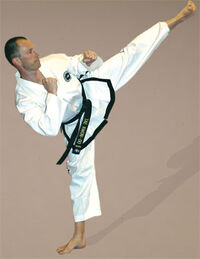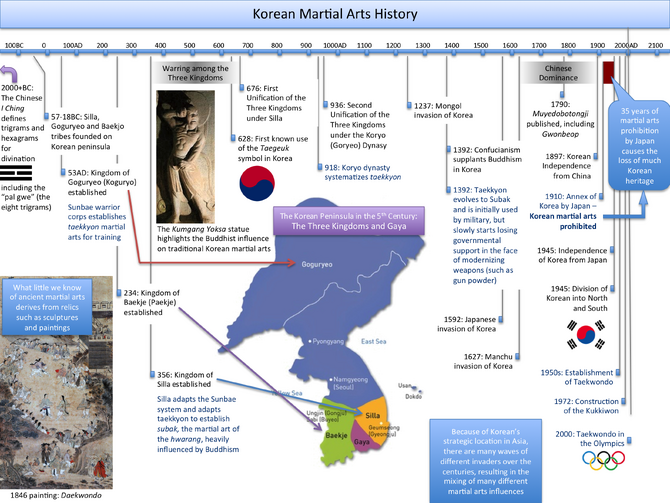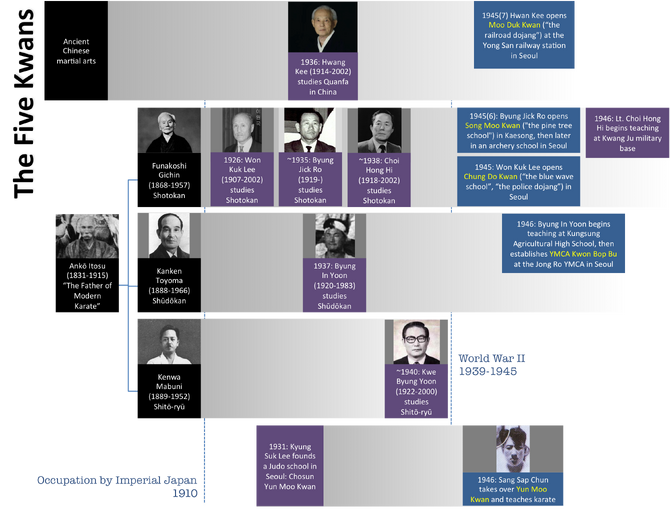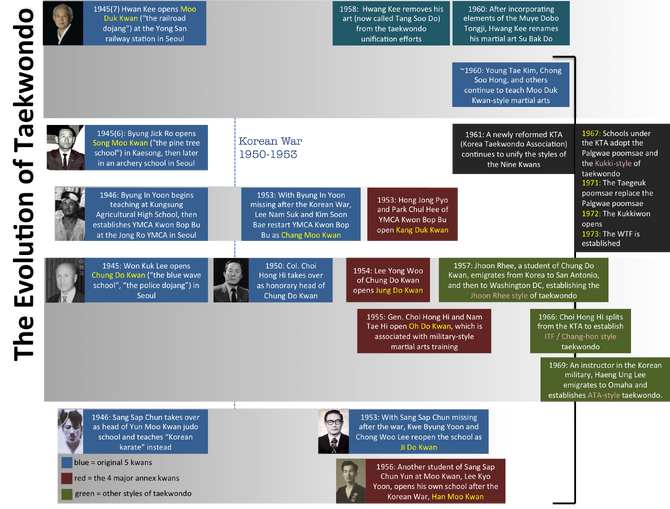| Taekwondo | |
|---|---|
 A high side kick | |
| Also called | Tae-Kwon-Do or Tae Kwon Do |
| Country of origin | Korea |
| Parent arts | Taekyyeon, Karate |
| Focus | Striking, especially kicks |
Taekwondo, Taekwon-Do or Tae Kwon Do is a Korean martial art, known for its use of high and spinning kicks.
Description[]
Taekwondo (Korean pronunciation: [tʰɛ.kwʌn.do]) is a Korean martial art and the national sport of South Korea. It is the world's most popular martial art in terms of the number of practitioners. Gyeorugi (Korean pronunciation: [gjʌ.rʊ.ɡi]), a type of sparring, has been an Olympic event since 2000.
In Korean, tae (Hangul: 태, hanja: 跆) means "to strike or break with foot"; kwon (Hangul: 권, hanja: 拳) means "to strike or break with fist"; and do (Hangul: 도, hanja: 道) means "way" or "method"; so "taekwondo" is loosely translated as "the way of the foot and fist" or "the way of kicking and punching". As with many other martial arts, taekwondo combines combat techniques, self-defense, sport, exercise, meditation and philosophy. Taekwondo is also used by the South Korean military as part of its training.
There are multiple styles of taekwondo. Among the most common are:
- ITF/Chang Hon: One of the oldest styles to use the name "taekwondo" is known as Chang Hon style taekwondo, developed primarily by Choi Hong Hi in the early 1960s. In 1965 Choi split from the nascent Korea Taekwondo Association (KTA) to establish the International Taekwon-do Federation (ITF).
- WTF/Kukkiwon: Meanwhile, the various martial arts schools in Korea (known as kwans) continued to consolidate and unify their disparate styles of taekwondo under the banner of the Korea Taekwondo Association (KTA). By 1967 the KTA had developed a style of taekwondo known as "kukki" style (the word "kukki" means "national" in Korean, so this was the "national" style). By 1972 construction of the government-sponsored Kukkiwon ("national academy" of taekwondo) was completed, and the style came to be known as Kukkiwon style. In 1973 the World Taekwondo Federation (WTF) was established as the governing body for international sports competitions using the Kukkiwon style.
- Jhoon Rhee: Before the establishment of the ITF, in 1960 Choi Hong Hi visited Jhoon Goo Rhee who operated a "Korean karate" club in San Antonio, Texas. Choi was already advocating for the name taekwondo and he convinced Jhoon Rhee to adopt the name taekwondo in his club. Thus Jhoon Rhee became the first resident "taekwondo" instructor in the U.S. In 1962 Rhee relocated to Washington DC and initially taught ITF/Chang Hon style taekwondo (again at the urging of Choi Hong Hi) but later (partly due to controversies surrounding Choi) developed his own style called Jhoon Rhee taekwondo (not to be confused with Rhee taekwondo, a major chain of taekwondo schools in Australia and New Zealand).
- ATA/Songahm: In 1969 Haeng Ung Lee (a former taekwondo instructor in the Korean military) emigrated to Ohama, Nebraska and began teaching his own style of taekwondo which he called Songahm style. Lee went on to establish the American Taekwondo Association (ATA) and sell ATA franchises to other school owners. The ATA later established international associations as well, the STF (Songahm Taekwondo Federation) and WTTU (World Traditional Taekwondo Union).
- GTF: In 1990 Park Jung Tae split from the ITF (again, due to controversies surrounding Choi Hong Hi) and established his own federation, the Global Taekwondo Federation (GTF). GTF-style taekwondo is similar to ITF/Chang Hon style but incorporates a number of additional forms.
- There are a number of niche styles of taekwondo as well, such as Ho-Am (Tiger Rock) and WanJeonHan Taekwondo. In addition, a number of hybrid martial arts incorporate taekwondo techniques, including:
- Chun Khun Do - developed by taekwondo pioneer Bok Man Kim, this martial art combines taekwondo with additional grappling techniques and weapons training.
- Gwon Gyokdo - combines taekwondo and muay thai.
- Han Moo Do - Scandinavian martial art that combines taekwondo, hapkido, and hoi jeon moo sool.
- Han Mu Do - Korean martial art that combines taekwondo and hapkido.
- Iin Tae Kwon - a modern taekwondo hybrid developed by taekwondo pioneer Joon Jae Lee, Iin-Tae Kwon combines Traditional Taekwondo with additional techniques including weapon disarms, joint-locks, and take-downs.
- Kajukenbo - an American hybrid combining Karate, Tang Soo Do, Judo, Jujutsu, Kenpo, and Boxing.
- Teukgong Moosool - Korean martial art that combines elements of taekwondo, hapkido, judo, kyuk too ki, and Chinese martial arts.
- Yongmudo - developed at Korea's Yong-In University, combines taekwondo, hapkido, judo, and ssireum.
- Tong Che Bahk Do - U.S. martial art that combines traditional taekwondo, karate, and kung fu.
Separate from the various taekwondo organizations, there have been two general branches of taekwondo development: traditional and sport. The term Traditional Taekwondo typically refers to the martial art as it was established in the 1950s and 1960s. "Sport" taekwondo has evolved in the decades since then and has a somewhat different focus, especially in terms of its emphasis on speed and competition (as in Olympic sparring), whereas Traditional Taekwondo tends to emphasize power and self-defense. The two are not mutually exclusive, and the distinctions between them are often blurred.
Although there are doctrinal and technical differences between the two main styles and among the various organizations, the art in general emphasizes kicks thrown from a mobile stance, employing the leg's greater reach and power (compared to the arm). Differences between these styles hinge largely on minor variations in techniques; use of different forms (poomsae, teul, hyeong); and different rules for sport competition (specially sparring rules). Taekwondo training generally includes a system of blocks, kicks, punches, and open-handed strikes and may also include various take-downs or sweeps, throws, and joint locks. Some taekwondo instructors also incorporate the use of pressure points, known as jiapsul, as well as grabbing self-defense techniques borrowed from other martial arts, such as Hapkido and Judo.
For additional detail, see:
Brief History[]
The oldest Korean martial art was an amalgamation of unarmed combat styles developed by the three rival Korean Kingdoms of Goguryeo, Silla, and Baekje, where young men were trained in unarmed combat techniques to develop strength, speed, and survival skills. The most popular of these techniques was ssireum and subak, with taekkyeon being the most popular of the components of subak. The Northern Goguryeo kingdom was a dominant force in Northern Korea and North Eastern China prior to the 1st century CE, and again from the 3rd century to the 6th century. Before the fall of the Goguryeo Dynasty in the 6th century, the Shilla Kingdom asked for help in training its people for defense against pirate invasions. During this time a few select Silla warriors were given training in taekkyeon by the early masters from Goguryeo. These Shilla warriors then became known as the Hwarang. The Hwarang set up a military academy for the sons of royalty in Silla called Hwarang-do, which means "the way of flowering manhood." The Hwarang studied taekkyon, history, Confucian philosophy, ethics, Buddhist morality, social skills, and military tactics. The guiding principles of the Hwarang warriors were based on Won Gwang's five codes of human conduct and included loyalty, filial duty, trustworthiness, valor, and justice. Taekkyeon spread throughout Korea as the Hwarang traveled throughout the peninsula.
In spite of Korea's rich history of ancient and martial arts, Korean martial arts faded into obscurity during the late Joseon Dynasty. Korean society became highly centralized under Korean Confucianism, and martial arts were poorly regarded in a society whose ideals were epitomized by its scholar-kings. Formal practices of traditional martial arts such as subak and taekkyeon were reserved for sanctioned military uses. However, taekkyeon persisted into the 19th century as a folk game during the May-Dano festival, and was still taught as the formal military martial art throughout the Joseon Dynasty.
In 1910 Korea was occupied by Imperial Japan and the practice of Korean folk traditions (including martial arts) was prohibited. This occupation lasted until 1945, the end of World War II. Traditional Korean martial arts -- already faded into relative obscurity before the occupation -- were almost completely eliminated by the occupation.
When the Japanese occupation of Korea ended in 1945, Korean martial arts schools (kwans) began to open in Korea. Most of the men who opened these schools had studied karate while in Japan during the occupation, though many had studied other martial arts as well, including Chinese martial arts and older, traditional Korean martial arts such as taekkyon. As these schools grew in size, many opened "annex" locations to accomodate the growth. The initiation of new schools came to an end in 1950 however with the advent of the Korean War. When the war ended in 1953, new schools again began to appear, typically started by students of the original five kwans.
In 1952, at the height of the Korean War, a martial arts exhibition was performed for South Korean President Syngman Rhee. In one demonstration, Name Tae Hi smashed 13 roof tiles with a punch. Following this demonstration, Rhee instructed Choi Hong Hi to introduce the martial arts to the Korean army. Rhee ordered that the various schools unify under a single system. The name "taekwondo" was submitted by either Choi Hong Hi (of the Oh Do Kwan) or Duk Sung Son (of the Chung Do Kwan), and was accepted on April 11, 1955. The Korea Taekwondo Association (KTA) was formed in 1959-1961 to facilitate the unification.
In the early 1960s, taekwondo made its debut worldwide with assignment of the original masters of taekwondo to various countries. Standardization efforts in South Korea stalled, as the kwans continued to teach differing styles. Another request from the Korean government for unification resulted in the formation of the Korea Tae Soo Do Association, which changed its name to the Korea Taekwondo Association in 1965 following a change of leadership. The International Taekwon-Do Federation was founded in 1966, followed by the World Taekwondo Federation in 1972.
Since 2000, taekwondo has been one of only two Asian martial arts (the other being judo) that are included in the Olympic Games. It became a demonstration event at the 1988 games in Seoul, and became an official medal event at the 2000 games in Sydney. In 2010, taekwondo was accepted as a Commonwealth Games sport.
One source estimated that as of 2009, taekwondo was practiced in 123 countries, with over 30 million practitioners and 3 million individuals with black belts throughout the world. The South Korean government in the same year published an estimate of 70 million practitioners in 190 countries.
For additional detail see:
Features & Culture[]
Taekwondo is known for its emphasis on kicking techniques, which distinguishes it from martial arts such as karate or northern styles of kung-fu. The rationale is that the leg is the longest and strongest weapon a martial artist has, and kicks thus have the greatest potential to execute powerful strikes without successful retaliation. Historically, the Koreans thought that the hands were too valuable to be used in combat.
Taekwondo as a martial art is popular with people of both genders and of many ages. Physically, taekwondo develops strength, speed, balance, flexibility, and stamina. An example of the union of mental and physical discipline is the breaking of boards, which requires both physical mastery of the technique and the concentration to focus one's strength.
A taekwondo student typically wears a uniform (dobok 도복), often white but sometimes black or other colors, with a belt (tti 띠) tied around the waist. The belt indicates the student's rank. The school or place where instruction is given is called the dojang 도장.
Although each taekwondo club or school will be different, a taekwondo student can typically expect to take part in most or all of the following:
- Learning the techniques and curriculum of taekwondo
- Both anaerobic and aerobic workout, including stretching
- Self-defense techniques (hosinsul 호신술)
- Patterns (also called forms, pumsae 품새, teul 틀, hyeong 형)
- Sparring (called gyeorugi 겨루기, or matseogi 맞서기 in the ITF), which may include 7-, 3-, 2- and 1-step sparring, free-style sparring, arranged sparring, point sparring, and other types
- Relaxation and meditation exercises
- Throwing and/or falling techniques (deonjigi 던지기 and tteoreojigi 떨어지기)
- Breaking (gyeokpa 격파 or weerok), using techniques to break boards for testing, training and martial arts demonstrations. Demonstrations often also incorporate bricks, tiles, blocks of ice or other materials. Can be separated into three types:
- Power breaking - using straightforward techniques to break as many boards as possible
- Speed breaking - boards are held loosely by one edge, putting special focus on the speed required to perform the break
- Special techniques - breaking fewer boards but using jumping or flying techniques to attain greater heights, distances, or to clear obstacles
- Exams to progress to the next rank
- A focus on mental and ethical discipline, justice, etiquette, respect, and self-confidence
Some schools teach the use of the "sine wave" when performing patterns; this involves raising one's center of gravity between techniques, then lowering it as the technique is performed, producing the up-and-down movement from which the term "sine wave" is derived. Other schools teach that one's center of gravity should remain generally constant throughout the performance of a pattern except where the pattern's description states otherwise.
Ranks, belts and promotion[]
Taekwondo ranks are typically separated into "junior" and "senior" or "student" and "instructor" sections. The junior section typically consists of ten ranks indicated by the Korean word geup 급 (also Romanized as gup or kup). The junior ranks are usually identified by belts of various colors, depending on the school, so these ranks are sometimes called "color belts". Geup rank may be indicated by stripes on belts rather than by colored belts. Students begin at tenth geup (often indicated by a white belt) and advance toward first geup (often indicated by a red belt with a black stripe).
The senior section is typically made up of nine ranks. These ranks are called dan 단, also referred to as "black belts" or "degrees" (as in "third dan" or "third-degree black belt"). Black belts begin at first degree and advance to second, third, and so on. The degree is often indicated on the belt itself with stripes, Roman numerals, or other methods; but sometimes black belts are plain and unadorned regardless of rank.
To advance from one rank to the next, students typically complete promotion tests in which they demonstrate their proficiency in the various aspects of the art before a panel of judges or their teacher. Promotion tests vary from school to school, but may include such elements as the execution of patterns, which combine various techniques in specific sequences; the breaking of boards, to demonstrate the ability to use techniques with both power and control; sparring and self-defense, to demonstrate the practical application and control of techniques; and answering questions on terminology, concepts, history, and so on, to demonstrate knowledge and understanding of the art. For higher dan tests, students are sometimes required to take a written test or to submit a research paper in addition to taking the practical test.
Promotion from one geup to the next can proceed fairly rapidly in some schools, since schools often allow geup promotions every two, three, or four months. Students of geup rank learn the most basic techniques first, then move on to more advanced techniques as they approach first dan. Many of the older and more traditional schools will often take longer to earn rank in than newer, more contemporary schools as they may not have standard testing intervals.
In contrast, promotion from one dan to the next can take years. The general rule is that a black belt may advance from one rank to the next only after the number of years equivalent to the current rank. For example, a newly-promoted third-degree black belt may not be allowed to promote to fourth-degree until three years have passed. Some organizations also have age requirements related to dan promotions, and may grant younger students pum 품 (junior black belt) ranks rather than dan ranks until they reach a certain age. Black belt ranks usually have titles associated with them, such as "master" and "instructor". Taekwondo organizations have their own rules and standards when it comes to ranks and the titles that go with them.
Philosophy[]
Since taekwondo developed in several different kwans, there are several different expressions of taekwondo philosophy. For example, the tenets of the ITF is said to be summed up by the last two phrases in the ITF Student Oath: "I shall be a champion of justice and freedom," "I shall build a better and peaceful world".[37] Alternatively, the Kukkiwon philosophy, the Han Philiosophy, is based on Eastern principles of samjae (삼재, three elements), eum (음, yin; negative or darkness) and yang (양, positive or brightness) with samjae referring to cheon (천, sky or heaven), ji (지, the earth), and in (인, a man or a person). The origins of these concepts originate from the Chinese classic "Book of Changes" which is considered to be one of the main canons of East Asian Philosophy.
For additional detail see:
Safety[]
Although taekwondo competitors have a substantial risk of injury, most injuries appear to be minor. A 2008 meta-analysis reported that an average of about 8% of competitors are injured, per exposure to competition; age, gender, and level of play did not significantly affect the injury rate.


